Whether you’re heading to a festival or pitching up at a campsite with the whole family, nothing spoils a trip faster than a bottle of sour milk and a warm can of beer. A reliable cool box is your best defence against such disappointments, and today’s models are designed to keep your provisions frosty, long after you’ve lost your phone signal. But which ones are actually up to muster?
From insulated picnic bags to heavy-duty ice chests, I’ve tested 14 of the best coolers and rounded up the ones that should keep you (and your hummus) fresh. Because no one should have to settle for tepid wine after the effort of pitching a tent.
At a glance
-
Best cool box overall:
Coleman Pro cooler box
£135 at Millets -
Best budget cool box:
Campingaz Icetime Plus
£29.46 at B&Q -
Best electric cool box:
Outwell Ecocool
£149.44 at Amazon -
Best cool bag:
Quechua Backpack Cooler 100
£24.99 at Decathlon -
Best cool box for multiday chilling:
Oyster Tempo cooler
£353 at Oyster -
Best cool box on wheels:
Yeti Roadie 48 wheeled cool box
£400 at John Lewis
Why you should trust me
A keen camper and festival goer, I’ve learned the hard way that a decent cool box can make or break a trip. With a background in biology, I’m also acutely aware of the risks of food poisoning from ill-stored sausages and suspect coleslaw. So I put my scientific mind to devising a battery of tests to separate the coolest coolers from the lukewarm letdowns.
How I tested
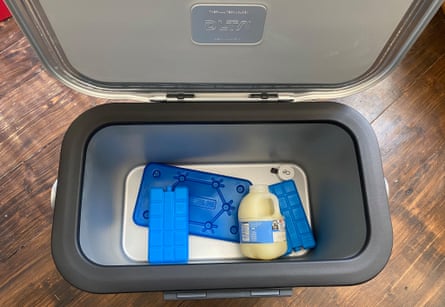
Ice retention, temperature consistency, portability and durability: I put all these metrics to the test. But my first (and most important) criteria was how long each cooler stayed cool. I prechilled each cool box with one standard ice pack per 6-7l capacity, then added a frozen one-pint plastic flagon of milk, and recorded how long it took for the internal temperature of the cool box to cool down to 8C – the maximum recommended by the UK Food Standards Agency to stop harmful bacteria from growing – and how long it took for the milk to defrost completely.
I used digital wireless thermometers to monitor the temperature inside the cool boxes, and each box was opened every four hours and after being left overnight to recreate the comings and goings of a campsite cook. My shortlisted cool boxes were then half filled with ice cubes, and I timed how long it took for these to completely melt.
For the electric cool boxes, I tested how long it took each one to reach its lowest temperature on the maximum setting, and then unplugged them and followed the same protocols as for the passive cool boxes to put their thermal performance to the test.
I filled each cool box (or bag) with 10kg of provisions and assessed how easy it was to lift into a car boot or carry 100 metres. Points were deducted for coolers that were too shallow to allow an opened bottle of wine to stand upright, and points added for features that enabled contents to be separated, thus avoiding such horrors as bacon juice mingling with your brie. Wheeled cool boxes were then hauled outside, where I tested how easily they rolled up and down kerbs and grassy slopes, and over asphalt and tree roots.
Below are the 10 cool boxes that performed best in my tests.
Tested cool boxes will either be returned to their manufacturers or donated to Kitsquad, a UK-based scheme that helps people with low incomes get out into the great outdoors.
The best cool boxes and cool bags in 2025
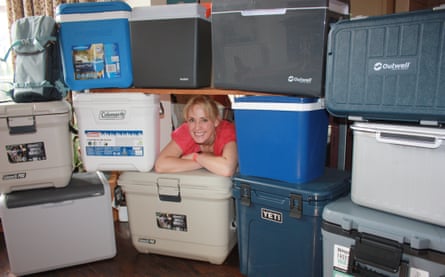
Best cool box overall:
Coleman Pro cooler box
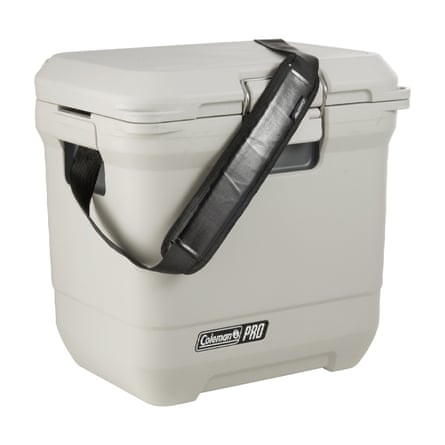
£135 at Millets
£129 at Amazon
The Coleman Pro takes its job seriously. With thick polyurethane foam insulation in both the lid and the body, it claims to keep food and drinks cold for up to 3.5 days – ideal for long weekends at festivals or off-grid campsites. At 24 litres, this cool box isn’t cavernous – but larger 42.5l and 52l versions are available that claim to retain ice for even longer (4.5 and 5 days respectively).
The metal latch is a small but satisfying detail, reducing the risk of this cooler spilling its contents if it gets knocked over; the antibacterial liner, which should help to keep bad smells at bay, is another; while its rugged plastic casing should render it tough enough to withstand muddy campsites and bumpy car boots.
Why we love it
This cool box ranked near the top in my ice retention tests, staying below 8C for 28 hours and keeping my milk partially frozen for 30 hours. It would doubtless perform better if it were filled with more contents and ice, too: indeed, when half filled with ice and left in an 18C room with the lid closed, it took four days and six hours for the ice to fully melt.
I also loaded up this cool box and took it to a festival for four days with only four medium ice blocks, and my food still felt acceptably cool by the end of it – although I’d have needed additional ice if camping for any longer than this.
This is a sturdy cool box, easily strong enough to double as a seat if needed, and it comes with a five-year guarantee. Its water drain is well designed, with only minimal liquid remaining after tipping, and I appreciated the inclusion of both side-handles and a padded and adjustable shoulder strap.
It’s a shame that … it doesn’t have cup holders in the lid, like its cousin the Coleman Xtreme Marine 28QT (below). Then it would be pretty much perfect.
Capacity: 24l
Inner size: 33 x 24 x 33cm (WDH)
Outer size: 45 x 35 x 45cm (WDH)
Weight: 4.9kg
Claimed ice retention: 3.5 days
Handles: padded shoulder strap, plus built-in grip slots on either side
Water drain: yes
Wheels: no
Best budget cool box:
Campingaz Icetime Plus

The Campingaz Icetime Plus is a passive cool box designed for short trips. The thick foam insulation in both its lid and body aims to keep contents cool for up to 24 hours, while its lid locking handle is designed to ensure a tight seal, helping to maintain the interior temperature.
Why we love it
This no-frills cool box may not turn heads, but it’s sturdier than it looks and would make a solid companion for overnight camping trips or festivals – where your main objective is keeping drinks cool. After adding ice blocks and a frozen bottle of milk, the cooler’s internal temperature dipped to a better-than-average 2.6C, and it stayed reliably at 8C for a respectable 15 hours – while the milk remained partially frozen for 22.5 hours. Remarkably, when this budget cool box was half filled with ice, it took nearly three days for it to melt – easily long enough to see campers through a weekend.
The lid is robust enough to double as an emergency seat, while the tough plastic shell feels capable of withstanding the usual campsite and festival indignities. It’s probably not built for prolonged heatwaves, but it should earn its keep in milder conditions.
It’s a shame that … the lid is hinged rather than fully removable, which may slightly hinder cleaning.
Capacity: 26l
Inner size: 33 x 24 x 33cm (WDH)
Outer size: 41 x 32 x 42cm (WDH)
Weight: 2.4kg
Claimed ice retention: 24 hours
Handles: solid plastic swing (top) handle
Water drain: no
Wheels: no
Best electric cool box:
Outwell Ecocool

£164.99 at Mountain Warehouse
£149.44 at Amazon
Designed to operate on both 12V and 230V power supplies, the Outwell Ecocool can be plugged in to your car (12V) or the mains (230V), and it will cool its contents to 18-25C below ambient temperature – or helpfully heat them to 60C if you’ve packed pasties rather than prosecco.
With a capacity of up to 35l, this cool box is tall enough to store 2l bottles upright. An internal divider also functions as an ice pack to assist cooling and further reduce energy consumption, while making it easier to locate objects within its cavernous interior.
The insulation is beefed up with polyurethane foam, and there’s an antimicrobial lining to fend off the bacterial horror show that can bloom in other such containers.
Why we love it
The Ecocool didn’t disappoint. It took five hours to consistently hit 2.75C – respectable for a unit of this size. Its internal divider, which doubles as an ice pack, should significantly accelerate this process, although I didn’t test this.
Where the Ecocool really shone was in cold retention. After switching off the power, it took one day and 9.5 hours for the internal temperature to reach 8C, and another 1.5 hours for a pint of milk to fully defrost. When half filled with ice, it took three-and-a-half days to fully melt.
Like most electric cool boxes, it produced a noticeable hum in Max mode. While Eco mode was quieter, it was still audible. However, given its excellent insulation, the Ecocool could easily be switched off while you sleep without compromising food safety.
Another feature that impressed me was the split lid. Dividing the top into two hinged sections means you can open one side at a time, reducing cold air loss, and making it easier to grab a bit of milk without disturbing everything else inside.
It’s a shame that … the plastic carry handle wasn’t the sturdiest of those I tested; that said, as an electric cool box, it’s unlikely to be hauled far on foot. It’s also annoying that the lid automatically closes and must be manually held open – although this is presumably to reduce cold air loss and energy.
Capacity: 35l
Inner size: 44 x 25.5 x 31cm (WDH)
Outer size: 52 x 32 x 43cm (WDH)
Weight: 7.4kg
Claimed ice retention: not stated (cools to 18-25C below outside temperature; warms to 50-60C)
Handles: solid plastic swing (top) handle
Water drain: no
Wheels: no
Best cool bag:
Quechua Backpack Cooler 100
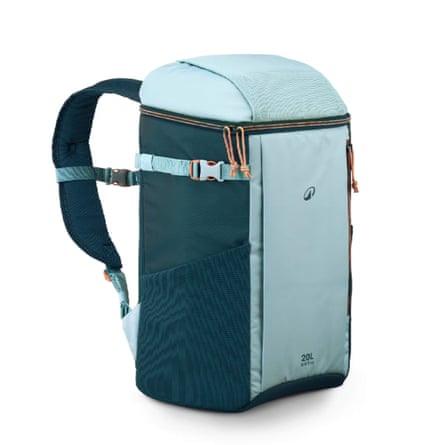
£24.99 at Decathlon
£25 at Argos
Designed to keep food and drinks cool during daylong outings, this insulated backpack is well stocked with storage options for stashing other necessities such as your wallet, keys and sunscreen. It has two mesh side pockets and two zipped compartments as well as the insulated inner zone. It also has adjustable straps, a foam back and waist and chest belts, and can be folded down for easy storage when not in use.
Why we love it
Sometimes the simplest ideas are the most effective: you’re hiking to the beach and want your sandwiches and drinks to stay cool, but you’ve also got towels, sun cream and other paraphernalia to carry, and lugging a handheld cool bag isn’t practical. This backpack offers a hands-free solution.
My expectations for its cooling capacity weren’t particularly high, so I was delighted to discover that it outperformed many of the solid cool boxes I tested. The internal temperature stayed below 8C for an impressive 23 hours, and my bottle of milk took 27 hours to fully thaw. I didn’t deploy the ice cube test because this product is designed to be used with ice packs and isn’t fully waterproof.
The bag is also comfortable to wear, looks decent, and comes with enough side pockets to rival the day bag I usually use for our (all too tepid) family lunches. For a short hike or an overnight camping trip with minimal provisions – its capacity is only 20l – it’s a clever and affordable solution.
It’s a shame that … although the insulated compartment can be wiped clean, it’s not fully waterproof – something Decathlon clearly states on its website. This means that condensation from the chilled contents may sometimes leak through the seams, and spillages may also not be contained.
Capacity: 20l
Inner size: 28 x 18 x 38cm (WDH)
Outer size: 29 x 19 x 42cm (WDH)
Weight: 0.48kg
Claimed ice retention: seven hours
Handles: backpack
Water drain: no
Wheels: no
Best cool box for multiday chilling:
Oyster Tempo cooler

The Oyster Tempo cooler introduces a novel approach to portable cooling: using vacuum insulation to maintain low temperatures without the need for large quantities of ice. Just two large ice packs should be enough to reach and hold temperatures three times colder than ordinary premium coolers, the company suggests. In theory, this should mean more usable space, plus days and days of chilled food – with no electric socket in sight.
Constructed with a lightweight aluminium body, Oyster claims the Tempo is both durable and recyclable. With its sleek lines and matt silver exterior, it also looks rather beautiful. These cool credentials come at a cost, however: at £353, this is the second most expensive product I tested.
Why we love it
Strong claims demand strong evidence – so I ran my milk test twice: the first time, using standard ice blocks at the same ratio of frozen milk to ice as the other cool boxes; the second using my standard one-pint flagon of frozen milk plus the two large Tempo-branded ice blocks.
My results were impressive: after my first test, the internal temperature dropped to 1C and was still just 2.2C after 24 hours. It didn’t rise above 8C until the next day (37 hours) – and even then, the milk took another three hours to thaw.
Swapping in the Tempo ice blocks gave even chillier results: after plunging to -1.6C, it took just over two days (49.5 hours) to cross the 8C threshold, and it took a further 2.5 hours before the milk was fully thawed. When half filled with ice, it took five days and 17 hours for the ice to completely melt.
The Tempo was straightforward to use. I loved the sturdy latches, which enabled the lid to hinge open – or be taken clean off, if necessary.
It’s a shame that … the price tag is high – and higher still if you want the aluminium carry handle (£41) or two ice packs (£54). The shoulder strap isn’t padded, so carrying heavy loads is quite uncomfortable. The cool box isn’t tall enough for a standard bottle of wine to stand upright, and its aluminium interior dented when I accidentally dropped a can of beer into it, so this may not be the most durable cool box on the market.
Capacity: 23l
Inner size: 41.5 x 21.2 x 26.8cm (WDH)
Outer size: 51.2 x 30 x 32cm (WDH)
Weight: 5.5kg
Claimed ice retention: not stated
Handles: adjustable fabric shoulder strap. Solid aluminium swing (top) handle also available to buy separately
Water drain: no
Wheels: no
after newsletter promotion
Best cool box on wheels:
Yeti Roadie 48 wheeled cool box
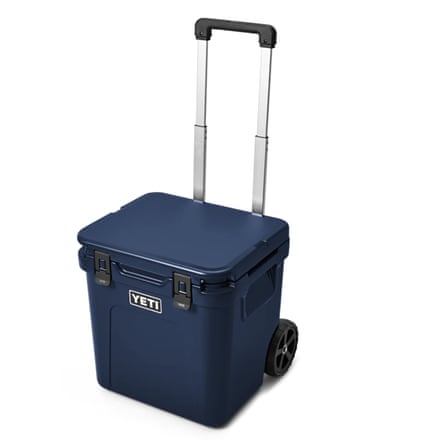
£400 at John Lewis
£400 at Amazon
Yeti loves its trademarks, and the Roadie 48 is no exception. Equipped with PermaFrost™ insulation (polyurethane foam injected into the walls under pressure), an Interlock™ lid system, a ColdLock™ gasket (tightly fitting lid with a thick rubber seal) and a Quicklatch™ (soft, flexible latch system), this cool box is engineered to keep food fresh for days.
It’s been moulded from a single, seamless piece of plastic designed to enhance its durability and resistance to impacts, and is equipped with solid, puncture-resistant tyres and tough, Neverfail™ hinges. If these ruggedness claims aren’t enough, the Roadie 48 also comes with a five-year warranty.
Why we love it
This is a hulking tank of a cooler, fit for an expedition to Death Valley rather than a weekend in Devon. While it lacks integrated ports to padlock it shut, and therefore hasn’t been certified bear-resistant as some other Yeti models have, it’s still a very robust cool box, possibly to the point of overkill.
If a 48l cool box isn’t gigantic enough for your needs, there’s also a 60l version (as well as smaller 15, 24 and 32l designs). Yet, despite its size, trundling the Yeti Roadie over various surfaces was a breeze.
Its ice retention was also impressive: the internal temperature took 22 hours to climb from 1.9C to 8C; and 24 hours for my pint of milk to fully defrost.
Yeti doesn’t make specific claims about ice retention, emphasising that this varies based on ice quantity, ambient temperature, and how often the cooler is opened. However, when I half filled it with ice and left it in an 18C room, it took five days and 20 hours to fully melt.
I also tested the much larger Coleman Pro 55QT wheeled cooler box (£222.99 at Decathlon), which I’d recommend as a cheaper alternative (it was so big, my 12-year-old son could fit inside it). It was narrowly pipped to this list because the Yeti was easier to pull on grass and lumpy ground and had a smaller footprint. However, it kept its cool for longer than the Yeti in my frozen milk test (26 hours v 24 hours), and Coleman claims this model can retain ice for up to five days.
It’s a shame that … the interior of this cool box is so huge, making it hard to organise and locate specific contents. Although it comes with one dry goods basket, it can accommodate two – however, you need to buy this separately. Given that this cool box already costs £400, this feels a bit miserly.
The water drain also wasn’t great. Even when the cool box was tipped and wiggled about, a small amount of water remained in the bottom. There was no way of attaching the plug to the cool box, either, so care should be taken not to lose it.
Capacity: 48l
Inner size: 36.8 x 29 x 40.1cm (WDH)
Outer size: 50.3x 51.1 x 52.3cm (WDH)
Weight: 11.7kg
Claimed ice retention: not stated
Handles: telescopic pull handle plus built-in grip slots on either side
Water drain: yes
Wheels: yes
The best of the rest

Ninja FrostVault wheeled cool box with dry zone

£179.99 at Ninja
£179.99 at Currys
Best for: festivals
The Ninja FrostVault comes with a “dry zone” – a chilled storage drawer below the main compartment to keep items separate – meaning no more digging through leaky packages of meat to find the hummus.
The box felt solid and was a breeze to wheel to the park, including over various obstacles. It could be a good option for festivals with a long walk in – although, given its high price tag, you’d want a means of concealing it from thieves. Some users also complain that it is heavy to lift and pull long distances when fully loaded: I didn’t find this, but I’m 5ft 8in and quite strong.
Its ice retention was also pretty cool: it took 29 hours for the internal temperature to hit 8C, and 30 hours for a frozen pint of milk to fully thaw. When half loaded with ice, it took three days and 22 hours to melt.
This cool box also had the best-designed drain of all those I tested, requiring minimal tipping or agitation to empty itself. 42 and 61l versions of this cooler are also available, and Ninja offers a five-year guarantee upon registration of these products.
It didn’t make the final cut because … it takes up a lot of space for a 28l cool box – with a footprint almost as large as the 48l Yeti Roadie. This may be problematic if you have a small car.
Capacity: 28l; inner size: 29 x 35 x 24cm (WDH); outer size: 50 x 50 x 48cm (WDH); weight: 13.1kg; claimed ice retention: not stated (expected to maintain temperatures below 4.4C for approximately five days in 35C weather when filled with ice); handles: telescopic pull handle plus built-in grip slots on either side; water drain: yes; wheels: yes
Hydro Flask Carry Out soft cooler

£63 at Ellis Brigham
£69.95 at Amazon
Best for: picnics for two
With its curved lines and soft green, blue or black colour options, this is an undeniably pretty cooler for day trips and picnics. In my tests, it stayed below 8C for 19 hours and kept a pint of milk semi-frozen for a similar amount of time (19.5 hours). The detachable shoulder strap was comfortable, and the fabric loop handles were well constructed, while the inner lining was waterproof and easy to wipe clean.
It didn’t make the final cut because … though attractive and well-designed, the Hydro Flask is expensive for what it is. It also doesn’t collapse for easy storage.
Capacity: 12l; inner size: 22 x 21.6 x 26.7cm (WDH); outer size: 30.5 x 21.6 x 29.2cm (WDH); weight: 839g; claimed ice retention: 24 hours; handles: fabric loop handles and detachable cross-body strap; water drain: no; wheels: no
Coleman 28QT Xtreme Marine cooler box
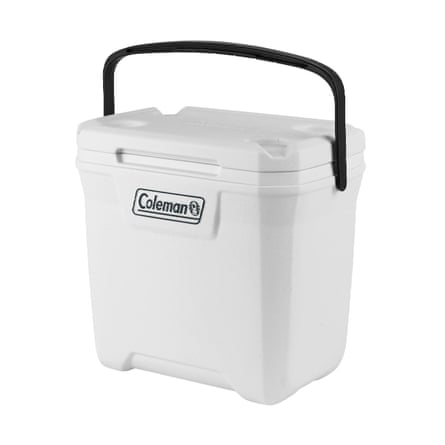
Best for: weekend camping trips
Designed for long days out fishing, this 26l cool box is equipped with UVGuard technology to prevent its hard plastic exterior from yellowing or cracking. I also loved the incorporation of four cup-holders into its lid, and it’s robust enough to sit on. When loaded with a frozen pint of milk and four standard ice blocks, its interior stayed below 8C for 25 hours, with the milk fully defrosted after 27, making it better than the average of all those on test.
Overall, this would be a sturdy investment for regular weekends away outdoors, with some clever design features.
It didn’t make the final cut because … its ice retention, although respectable, wasn’t the best. However, it’s more affordable than some of the higher-performance cool boxes I tested.
Capacity: 26l; inner size: 38 x 20 x 33cm (WDH); outer size: 46 x 33 x 40cm (WDH); weight: 3.1kg; claimed ice retention: three days; handles: solid plastic swing (top) handle; water drain: no; wheels: no
VonShef electric cool box

£61.99 at VonHaus
£61.99 at Tesco
Best for: a small electric cool box
If you don’t have loads of food to keep cool, this is a great performer. VonHaus claims it will chill to 14C below the ambient temperature – although in my own tests, it fared slightly better, taking just 1hr 50mins on full power to reach an internal temperature of 1.2C in an 18C room. Its internal temperature then stayed below 8C for an impressive 30.5 hours with the power switched off – after which a pint of milk had also just about defrosted. When half filled with ice, it took three days (72 hours) for the ice to become liquid with the power switched off.
This cool box can also be used for heating food to 50C, has an Eco mode for saving electricity, and comes with three power leads: a three-pin hole plug, 12V car plug and a USB-A lead.
It didn’t make the final cut because … if you only need to keep small amounts of food cool, you probably don’t need an electric cool box. It also wasn’t as well insulated as the other electric cool boxes I tested.
Capacity: 20l; inner size: 22 x 32 x 35cm (WDH); outer size: 25 x 38 x 40.5cm (WDH); weight: 3.71kg; claimed ice retention: not stated; handles: solid plastic swing (top) handle; water drain: no; wheels: no
What you need to know
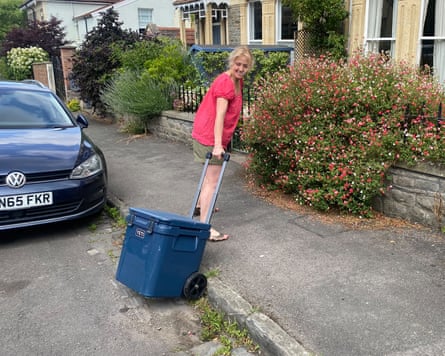
Passive cool boxes vs electric models
The choice between a passive and an electric cool box depends on how and where you’re planning to use it. Passive cool boxes rely on ice or ice blocks to keep cool. These take up valuable space, leaving less room for food and drinks, and can leave the contents soggy as the ice melts (particularly if there’s no water drain to let out melted ice). On the plus side, they require no power, and high-performing models can keep ice solid for days.
Electric cool boxes offer consistent plug-in cooling without the need for ice, but tend to be bulkier. You’ll also need an electricity source, such as a mains hook-up point, or a car/van battery (although they will quickly drain your battery if plugged in without the engine running). Many models can also be used to warm up food – although a stove or microwave will do so faster.
How to keep cool box contents cool for longer
Whether passive or electric, preparation is key to getting the best out of your cool box. Prechilling the box beforehand is a good idea – either using ice blocks or items from your freezer, such as frozen peas. Where possible, also try to precool food and drinks. You could even consider freezing items such as milk – but don’t attempt to freeze anything in a glass bottle or can, as they could burst.
When loading up your cool box, start by placing large ice blocks or frozen water bottles at the bottom or around the sides, then layer food and ice or ice blocks, packing the box as full as possible to reduce warm air pockets. Many manufacturers recommend a ratio of 2:1 ice to contents for the best performance, although this will reduce the amount of space available for food.
Once at the campsite, keep your cool box in the shade, cover it with a reflective blanket or light-coloured towel, and open it as little as possible, as every rummage lets in warm air. If your campsite has a freezer, consider bringing extra ice blocks so you can rotate them. Alternatively, many supermarkets sell bags of ice that you can use to top up your cool box on longer camping trips.
For electric cool boxes, precooling with ice blocks and/or mains power before switching to 12V can help to reach frosty temperatures faster.
Linda Geddes is a former Guardian science correspondent, renowned for inserting herself into her own mini-science experiments. This also extends to product testing, where she delights in devising rigorous ways to distinguish high performance from marketing puff. Outside work, she can frequently be found swimming in rivers, dangling from cliffs, and trudging the dawn walk to the campsite Portaloo

 2 months ago
103
2 months ago
103

















































